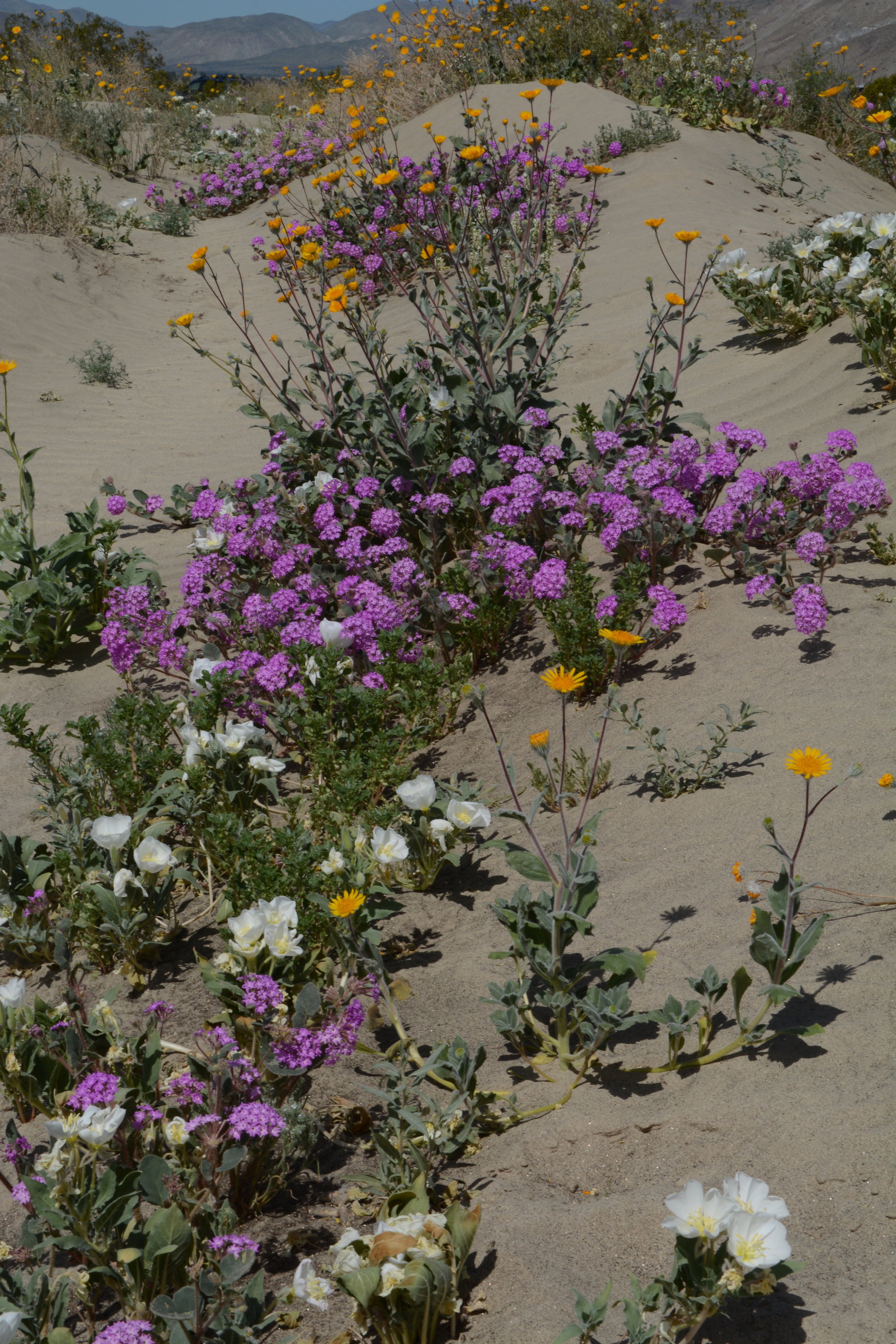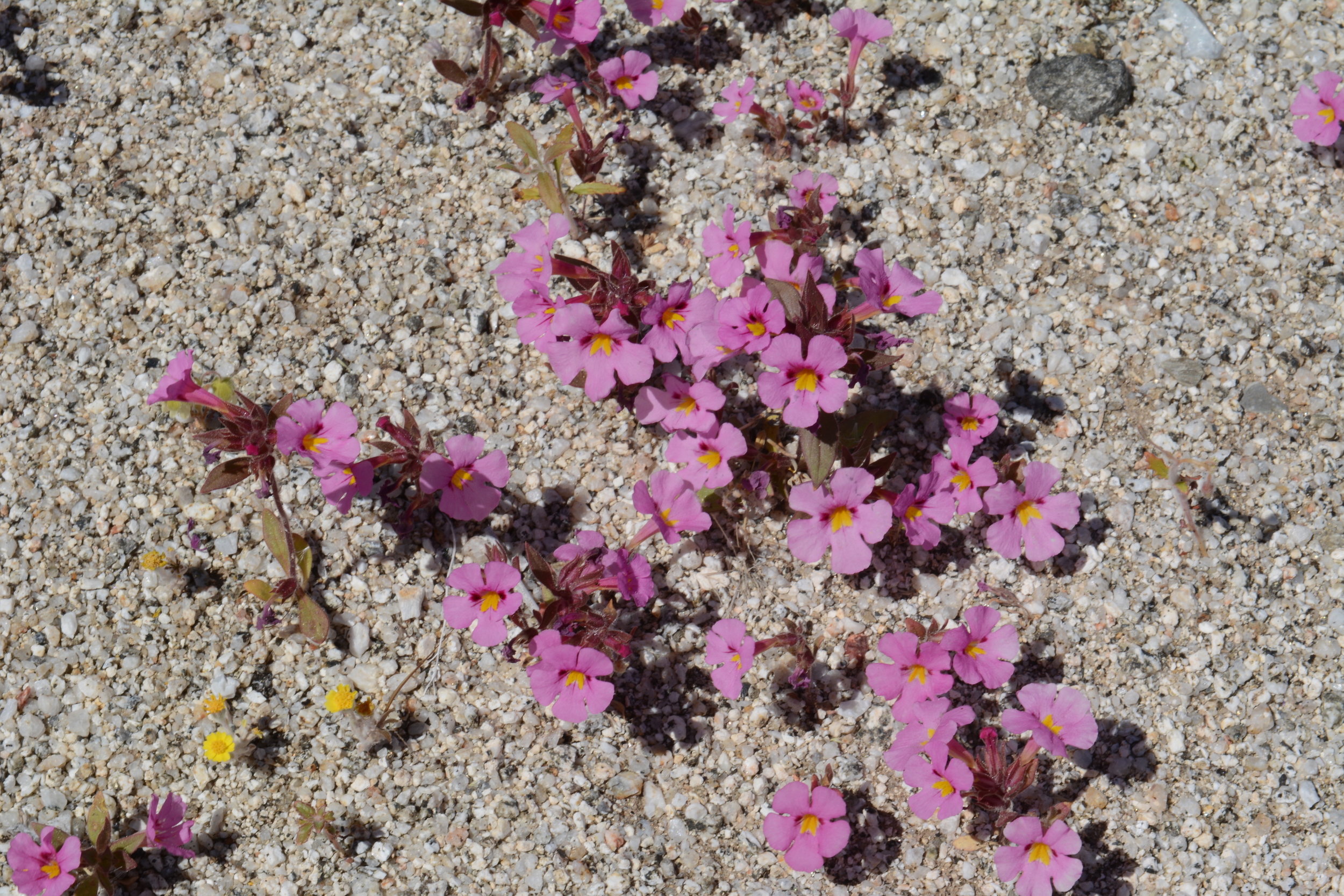
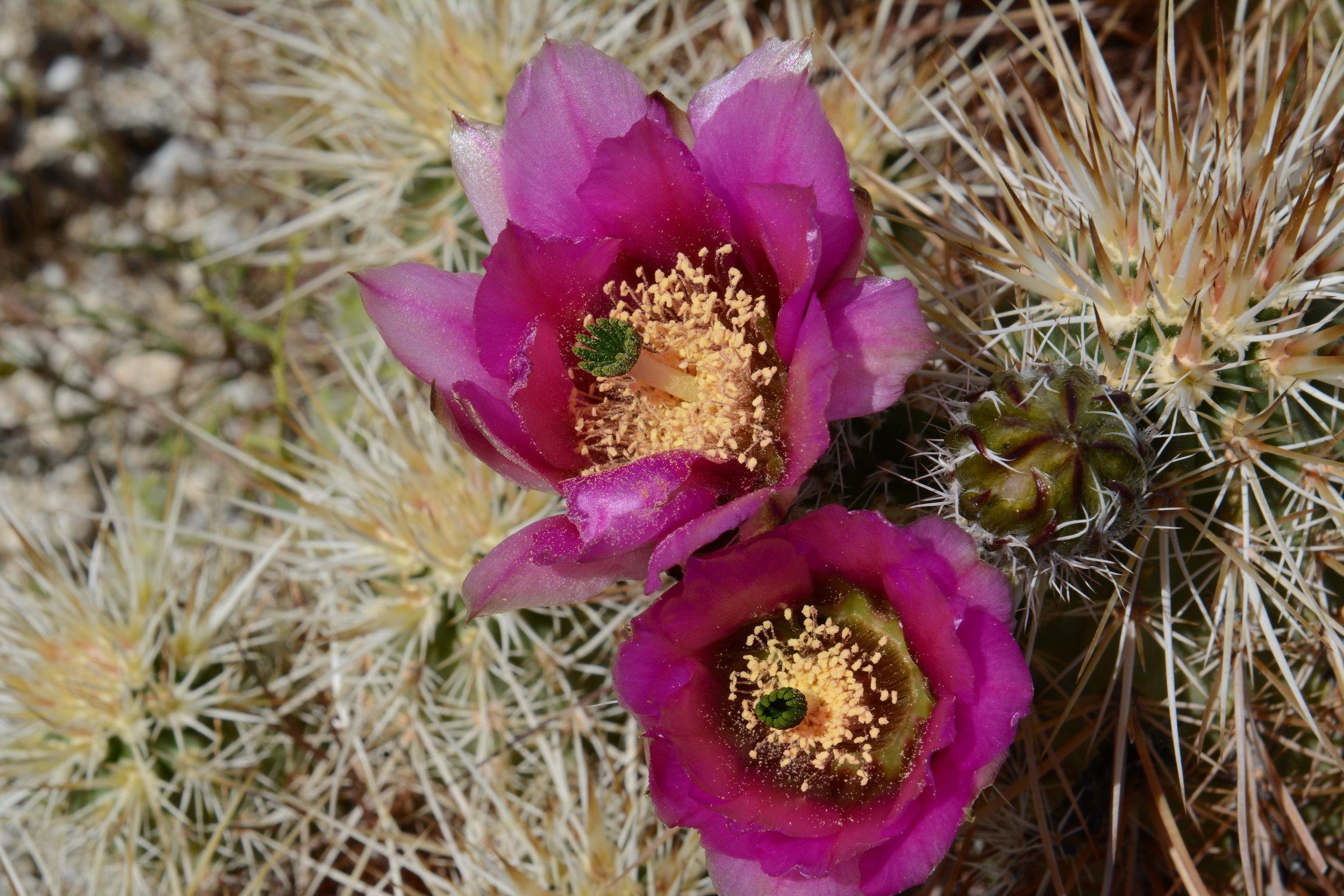

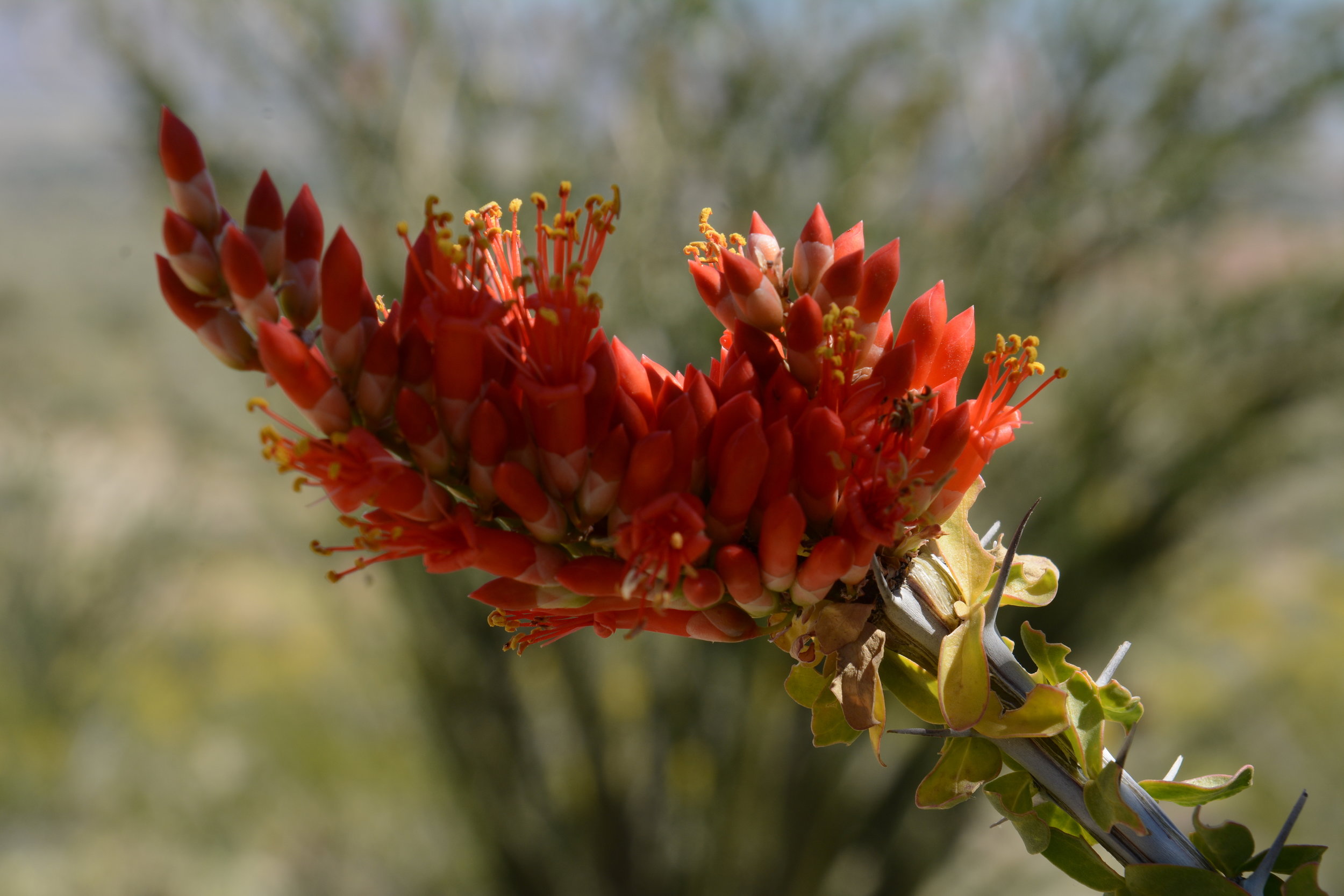
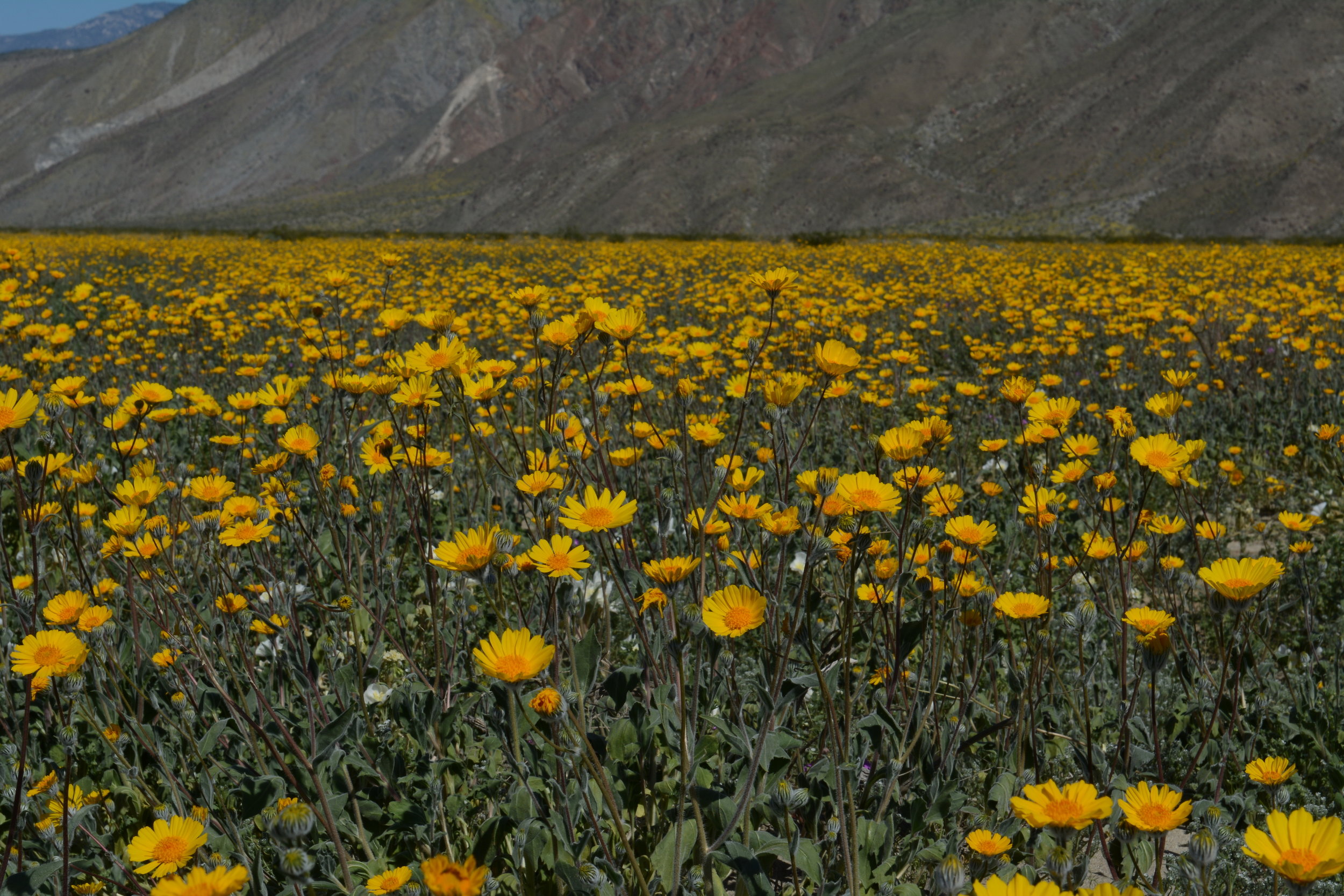
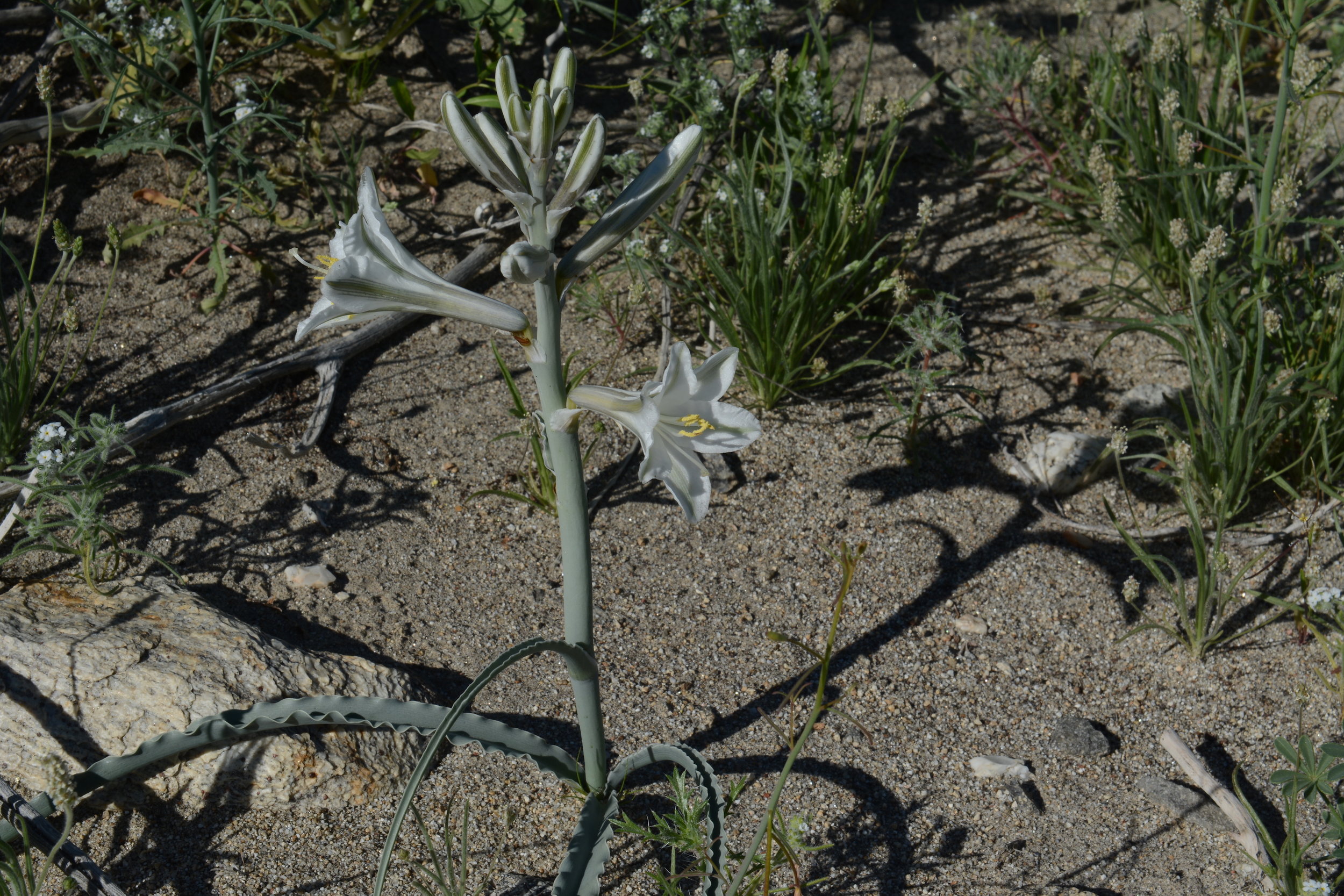
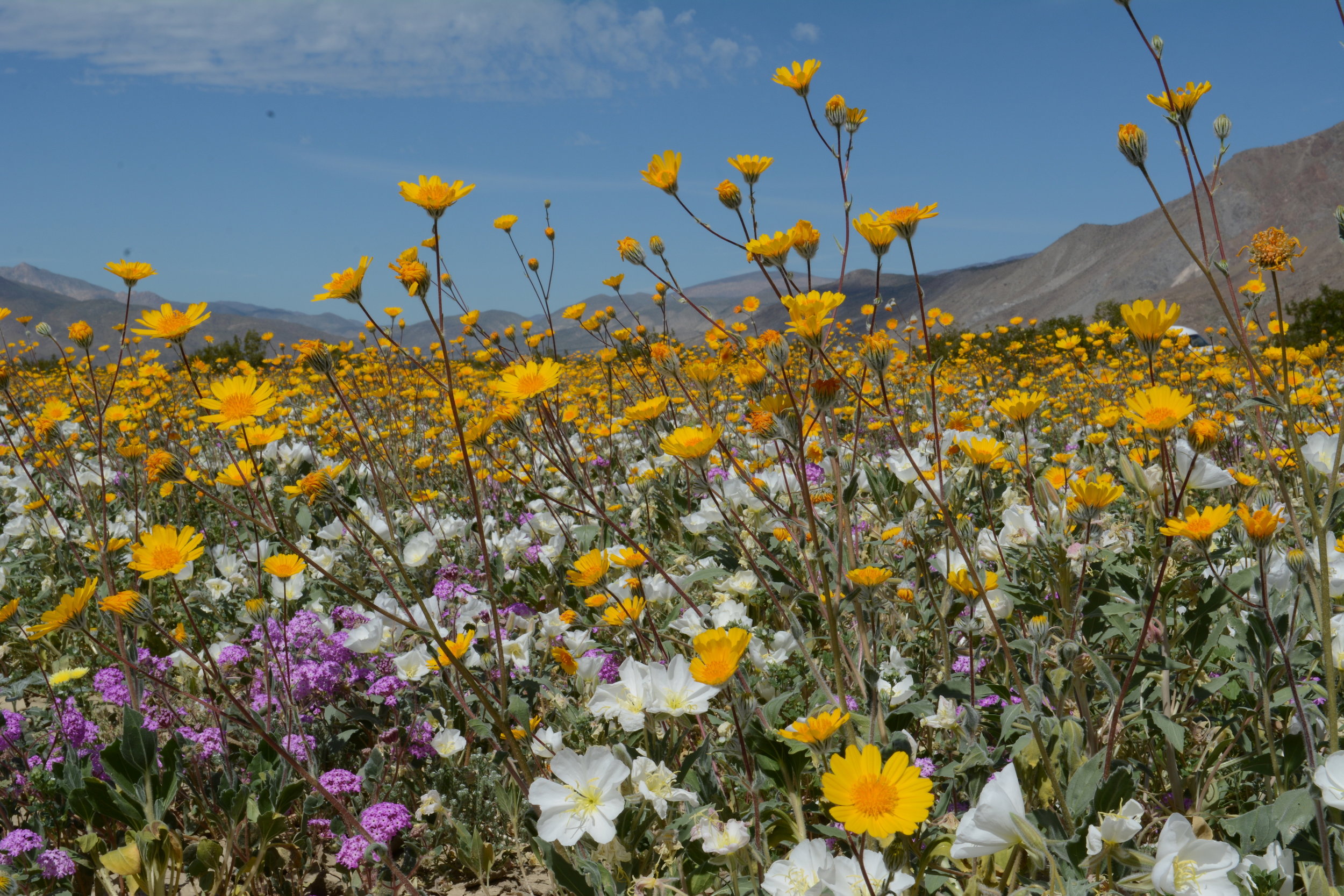
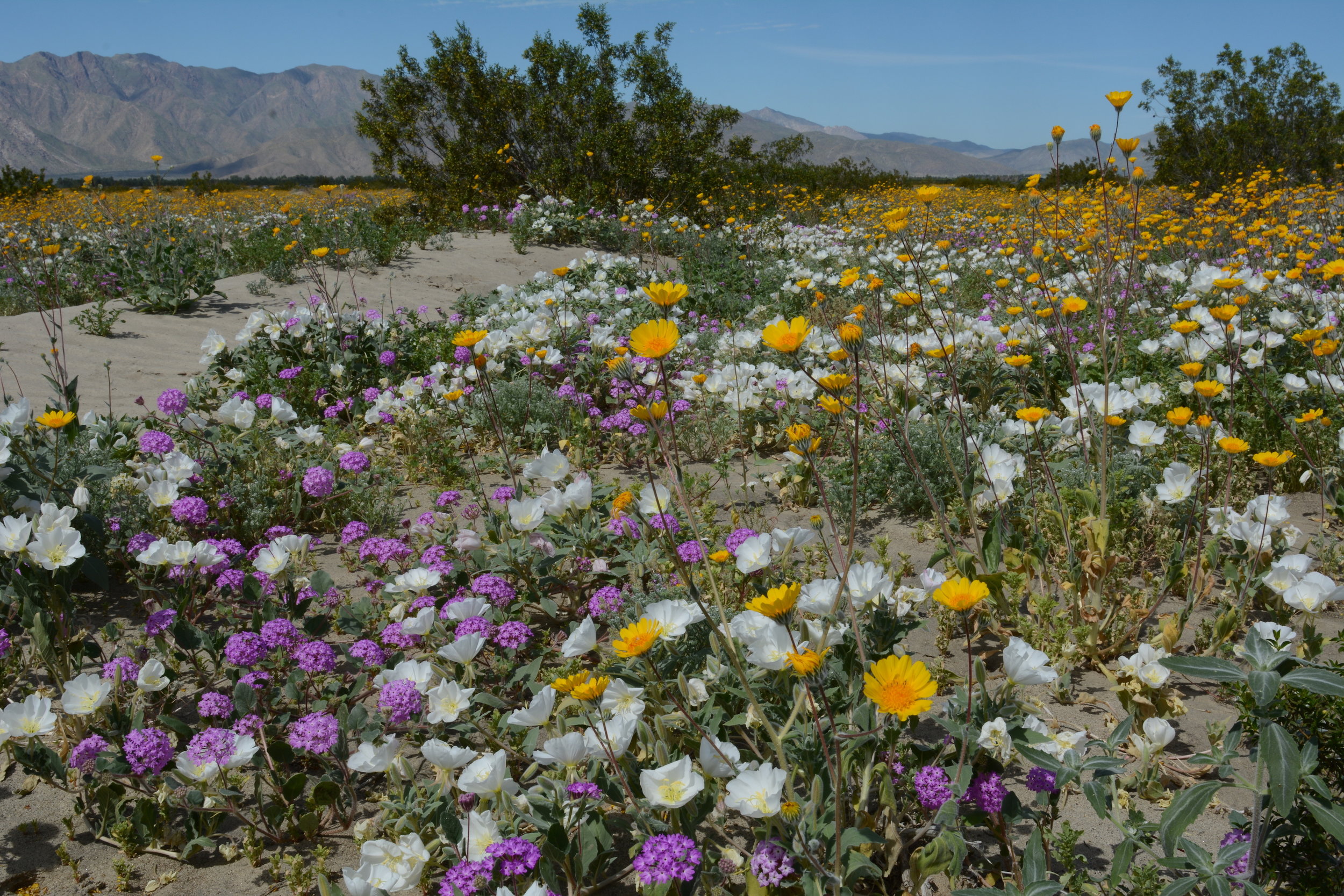
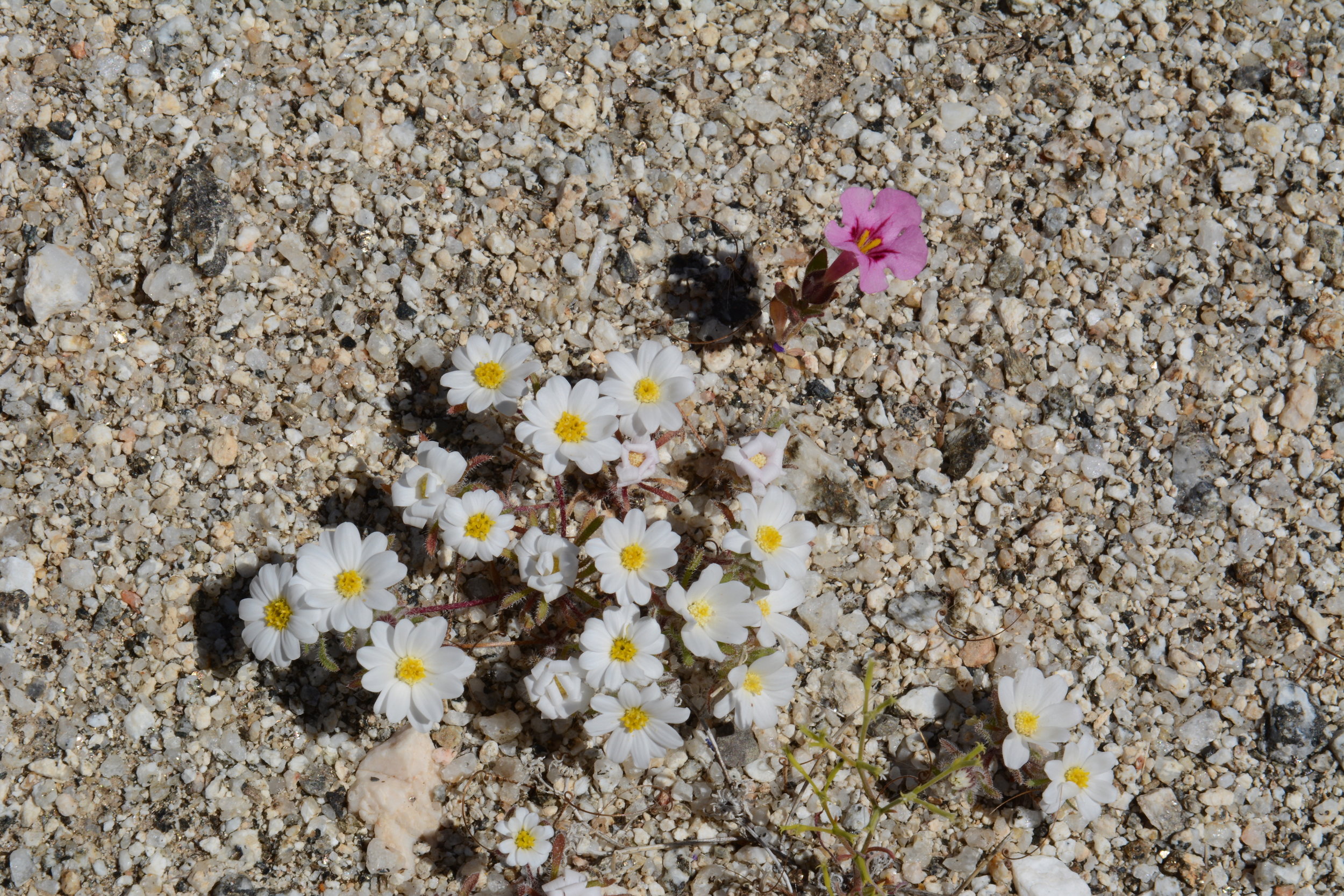
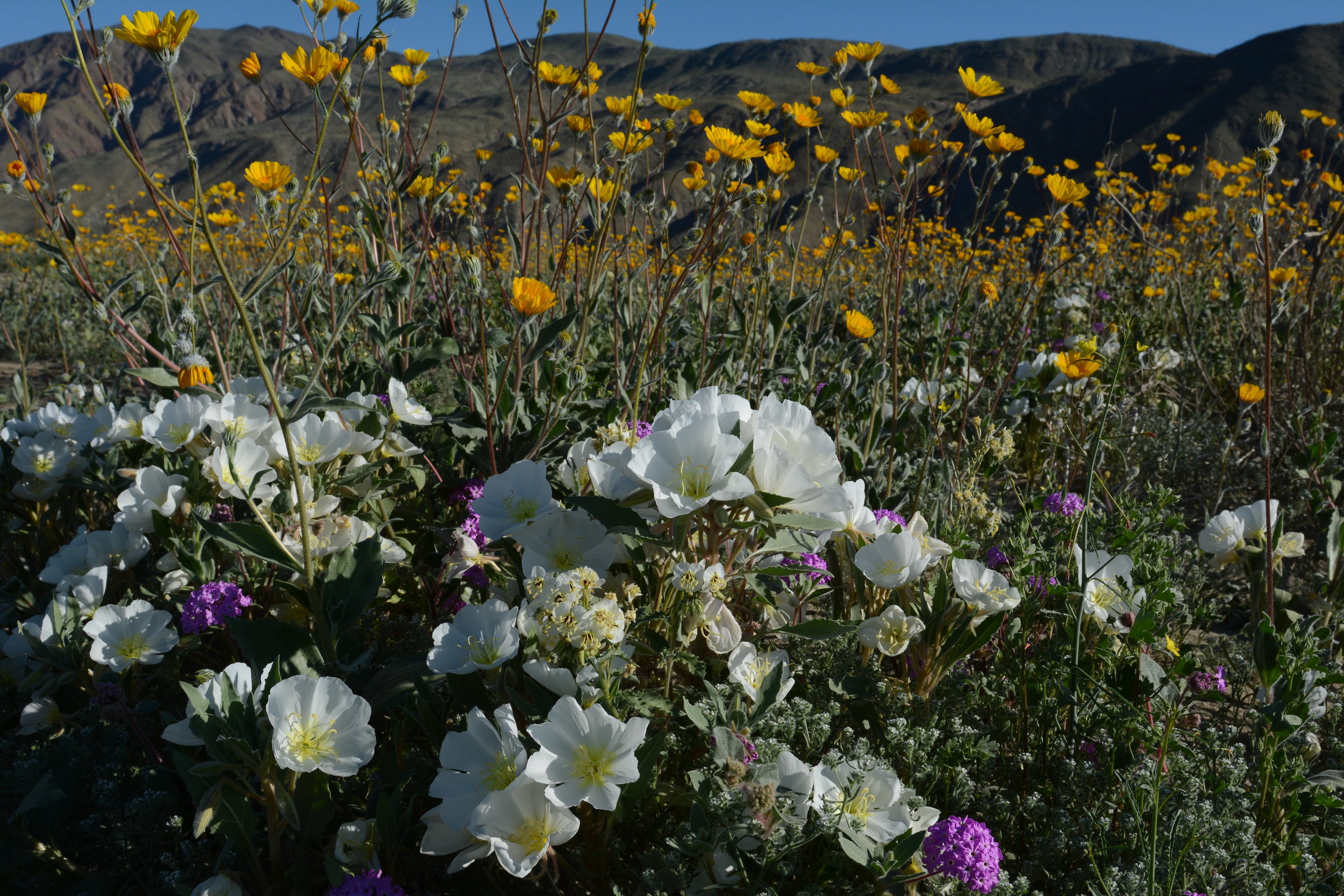
by Tom Oberbauer, Vice President CNPS-San Diego
For those of you who were not able to make it out to Borrego Valley this March, I am sorry.
I must admit, growing up, I was not especially fond of desert. I had only been through deserts on family road trips to elsewhere in the southwest. We always had to leave at 1 am to get through the desert before it was too hot. I grew up favoring mountains with forests over deserts. However, during an ecology class at SDSU, we had a project in the desert in the spring and I became more interested. I began to really appreciate the deserts, the starkness of the terrain, the pockets of unique habitats and the wildflowers. During the late 1970s and early 1980s, I was a naturalist on SDNHM ecology trips to the desert each spring.
There were some exceptional rainfall seasons at that time with exceptional wildflowers. They were 1978, 1979, 1980, 1983 and 1993. In 1995 and even 2005, the third wettest season in San Diego history, wildflower displays in Borrego were exceptional. I remember one spring driving out each weekend for a month to enjoy all of the phases.
This spring, talk came early about a good wildflower season in our desert, even though the rains began a bit later than was optimal. That was until we had that San Diego specialist storm on the Monday of February 27 when most of coastal San Diego County received 2-4 inches of rain while Los Angeles had less than a half an inch and Palomar Mountain had 9 inches. But what was more important was that Borrego received up to an inch and a half of rain taking the total to 7.29 inches. Then, the talk began to describe a “superbloom.”
It is always difficult to determine when flowers will peak but there were estimates that they would peak in mid-March. Various websites provide updates on the flowers: Desert USA and the Anza Borrego Natural History Association. It all looked good. However, I only had one potential day to go, a Monday in the middle of the month. Unfortunately, the temperatures began to climb, reaching successive days of over 90 degrees. That does not bode well for wildflowers. I was getting worried that they would be all cooked. In 1995, I spend one afternoon in Henderson Canyon Road with beautiful wildflowers. Coming back a week later when I went having convinced my wife to take off the afternoon, they were all toasted.
I began driving on March 13 at 6:15 am through heavy fog. I went east then north on I-15 then east through Poway. The fog lifted or more accurate, I drove above it, and went up Scripps Poway Parkway, through Ramona, through Santa Ysabel and north to the turnoff for San Felipe Valley and Montezuma Grade. The vegetation all seemed very healthy in the Coastal sage scrub with its gray green color and the dark chaparral accented by green grassy slopes and lowlands.
I had read about the traffic looking like I-405 on Friday so I really wanted to get there before most people, plus it was the first week day after the time change so I hoped for lower numbers.
Near Lake Henshaw, there are usually wildflower displays but this year, the grass and vegetation seemed very closely cropped without a hint of wildflower poppies and goldfields.
The countryside looked quite green in Ranchita. However, down the grade, there were hints of what was to come. I was not able to see any yellow in the valley from the highway, but shrubs along the road were in flower. Along the road, a number of different flowers were visible.
In the valley, I drove directly to Henderson Canyon road and drove east to the large, flat open area. The desert sunflowers (Geraea canescens) were clearly near their peak, nearly a meter tall and with most of the buds open. The flowers are a yellow orange in color and when in mass, they create a significant patch of color. The air was very still in the morning light, but they swayed gently in the breeze later.
The Oenothera deltoides (Evening primrose) were also in flower in low numbers mixed with the Geraea, but in white clumps in open and sandy areas. I always thought that they look like tissue paper along the road where they seem to do well in the disturbed soils. The pink purple Abronia villosa (Sand verbena) was also scattered through the area in patches, not very dense, at least in the first place I stopped. However, just moving a few hundred yards down the road, brought a different mix where the Oenothera was more numerous. Also, while 90% of the people went to the north side of the road, the south side showed much less effect of footprints. There, the big 4-petaled Oenothera flowers floated on their green stems and leaves that sometimes lie prostrate on the sand. Even though 7.29 inches is a lot of rain for the desert in this location, it is still a real wonder that the plants can grow so large in such a short amount of time. Coastal areas receive more rain to generate smaller flowers. While I was hunched down photographing, a large swarm of honey bees passed over me. I sat perfectly still as they streamed past.
People wonder how such delicate plants can grow with such profusion in the harsh desert. In fact, the annuals avoid the harsh conditions by only growing when there has been adequate rainfall. When it gets too hot, they are already done for the year. They are wonders of the desert community but they actually avoid the desert conditions.
I am also fully aware that if it was not for the local community purposefully removing Brassica tournefortii (Sahara mustard) plants, there would not be any wildflower locations in the area or they would be much less, small patches fighting for control of some land.
I noticed a number of cars parked at the Peg Leg Mine area, so I drove up there. The mix of flowers was quite diverse. The Abronia was more present in addition to the flowering Geraea canescens, many more Chalismia claviformes (Brown-eyed evening primrose), and other wildflowers, and especially Hesperocallis undulata (Desert lily). Desert lilies are an anomaly to me. I understand that they too avoid the harsh desert conditions. They are geophytic plants with bulbs beneath the soil. They are perennial plants that produce Easter lily-like flowers in the middle of harsh, sandy soil. They collect water and incorporate it into their bulb. They can put up a leaf if they receive enough rainfall and they will flower if they receive more. During dry years, you may not see them at all.
The numbers of people were increasing but it was still not unbearable. On DiGirogio Road, I noticed a number of cars pulled over. A vacant field to the west was covered with Malacothrix glabrata (Desert dandelion). Its sweet scent was strong. It was an abandoned field where the drip irrigation lines were still present. Farther down, another dense patch of Malacothrix occurred but it was set back from the road in an area that apparently had not been cultivated and had a more native appearance.
I decided to drive out to Coyote Canyon. So did a number of other people in their SUVs and pick-up trucks, even a few smaller motor homes. Passing became an issue since the road is not very wide and the edges are sandy. I observed one person who was stuck within 2 feet of the edge of the road. I drove out for a while passing a diverse designation of flowers: Camissoniopsis sp., Dytheria sp. (spectacle pod), Malacothrix glabrata (desert dandelion) and off in the distance, entire slopes were pale yellow. Closer up, I could see similar coloration caused by Eschscholzia parishii (desert poppy). They were large plants, each one about 2 feet or more in diameter with numerous flowers. They were a clear yellow color without any orange. I walked over to a slope and looked up where the vegetation grew in clusters a long distance up hill on rocky talus and larger rocks. Opuntia basilaris (Beavertail cactus) was in flower on the large slopes. The Fouquieria splendens (Ocotillo) had leaves but only buds. I drove back through the outskirts of town to the south.
Over Yaqui Pass, past Bow Willow Campground, and over to what is now called Shelter Valley (it was called Earthquake Valley when I was younger). There weren’t any large patches of color but the area near Vallecitos was green. I went farther and drove up to Mountain Palm Springs. There were numerous plants in flower including the Chalismia claviformes (Pinnate leaved primrose) and Eschscholzia minutiflora (Pygmy poppy). Water was oozing out in spots along the trail to the closest palms. By now, it was quite hot, probably in mid-90’s, but because it was dry and there was a breeze now, after noon, it was not too bad. Encelia farinosa (Brittlebush) was also in flower here and there but I came across an entire slope of them in flower, beautiful yellow bushes on a rock hilltop. Here, there were only 2 other cars in the entire area. While all the species were not here, the density of flowering plants, especially annuals, was very high. I even found an Eschscholzia minutiflora growing and flowering in a crack in the asphalt on the edge of the road. You know it is a good year when that happens.
Here and there, patches of Abronia popped up near the road. I thought I saw a Mimulus bigelovii near the border check station so I headed out the dirt road near there, but did not see any. What I did see were more desert lilies in the driest, most bare coarse sand material. How does such a pretty plant grow in such a stark environment?
I drove on south on S-2 and connected with I-8. Driving back west, Encelia was in flower along the highway. The climb back up past Mountain Springs always provides something new. I finally noticed the palm stand there that I had heard about. At the top of the grade, the weather changed. I was clearly passing into an area with coastal influence and haze, and moist air replaced the hot dry conditions below in the desert. The landscape was very green.
Even though the weather every day was in the mid- 90s, I continued to see reports that the wildflowers were going strong. On the Desert USA site, Anza- Borrego was rated as a 9 and a half of ten on their bar charts. I decided that I had to go see it again.
It was another early Monday morning through the fog, but this time the fog was in the mountains. When I arrived to Montezuma Grade, an eerie patch of cirrus clouds lay overhead, creating a definite diffused light. I drove to Henderson Canyon Road with the windows open and the scent of the flowers wafted through the air. A strong breeze blew down Coyote Canyon moving the flowers. The flowers in the Geraea site were still looking fresh, maybe just past the peak. However, south of the road in the dune hillocks, flowers were blossoming heavily. I was amazed that they would all still be in flower with the hot temperatures. In the lower lines, between the dunes, Oenothera was the dominant with white flowers. On the dune slopes, the magenta Abronia dominated. In between, they were equal with the Geraea in a dense mass. I could have spent hours there. My dark colored pants were covered with yellow and orange splotches of pollen from the flowers.
In Coyote Canyon, a few of the Ocotillo were commencing to flower even with leaves. Though they are in a leafless state most of the year, they flower after the leaves begin to dry. Ocotillo have two kinds of leaves. There are those that form with new growth that eventually dry and leave the dried petiole as a thorn, and those that grow each time there is adequate rain. I have seen them put out leaves and dry more than once in a year.
The flower display wasn’t just monocultures there either. Chaenactis stevioides (Desert pincushion), Malacothrix glabrata, some Lupinus arizonicus (Arizona lupine), Rafinesquia californica (California chicory), the sweet smoky scented Larrea tridentata (creosote bush), Encelia farinosa, Opuntia basilaris with flowers that were of a color that does not look real but brilliant magenta, and Loeseliastrum schottii (calicoflower) are just a few. There were numerous more. Large Eleodes beetles (big black stink bugs) cruised along the sand. White-lined sphinx moth caterpillars were becoming more numerous but not exceedingly so.
I sadly left the valley back up Montezuma Grade. In the bright light, a smear of orange was visible in the area of Henderson Canyon area where the Geraea was in flower. On the grade, Encelia farinosa was in full flower. Black-throated sparrows were flying and producing their trill call. I have come to equate these strikingly patterned sparrows with wildflowers, and Encelia farinosa in particular, because the only time I see them is when the shrubs are in flower.
During normal years, the Encelia right next to the road flowers because it receives moisture augmentation from the asphalt runoff. During wetter years, some of the Encelia on the adjacent slopes will flower. This year, every one, all the way up the mountain was in full bloom.
Being as obsessed as I am with wildflowers and ephemeral natural phenomena, I was able to talk someone else into going with me one more time to the desert, but this time to see the cascade in Palm Canyon and look for Mimulus. We arrived early and hiked up the canyon. Water cascaded loudly down a forked fall on two sides of a large rock landing in a level pool of glistening water. It is hard to believe that this happens in the dry, hot Anza-Borrego desert. The palm grove provided a delightful patch of shade while a canyon wren sang its descending whistle song. Later, we hiked into Hell Hole Canyon where the nearly continuous cover of Encelia shrubs were flowering on the north facing slopes, glowing yellow with the back light. Numerous small annuals grew on the sand including the brilliant white and diminutive Monoptilon bellioides (Desert star), the tiny yellow Eriophyllum wallacei (Wallace's woolly daisy), the small flowered Namademissa (Desertpurplemat),andofcoursethe Mimulus bigelovii (Desert monkey flower), which grew in profusion over a wide area.
I had seen a report of the Anza-Borrego “Superbloom” on national news when it began. I also read about a bus load of people who flew here from Hong Kong to see the flowers. As I reentered traffic of urban San Diego County, I was not sure how the term “superbloom” is defined. There certainly was a great expansion of wildflowers. It is too bad it was so hot to cook the annuals, but overall, I think the displays of wildflowers met or exceeded my expectations. I wish I had more time to explore more. It has been a while since it was this good and may not be like this again for who knows how long. Again, if you were not able to go to the Anza-Borrego Desert yourself this March, I am truly sorry.

